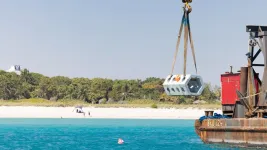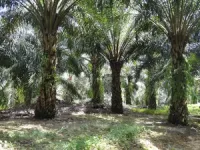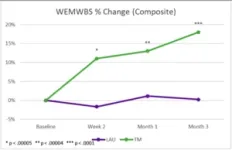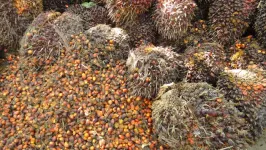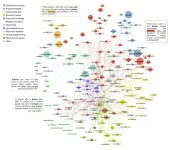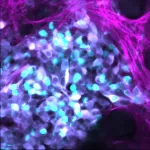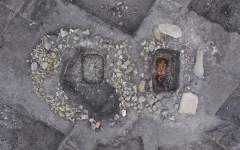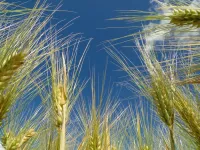(Press-News.org) The first piece of a series of concrete structures was lowered into the water off the coast of Miami Beach on Wednesday morning, a massive crane on the deck of a floating barge hoisting the unit into the air and sinking it to the seabed.
During the next six hours, crewmembers aboard the barge would repeat that process until the structures, some stacked on top of each other, were settled on the seafloor, 14 feet below the surface.
To casual observers onshore, the daylong operation might have seemed routine. But this maritime activity was hardly run-of-the-mill.
In a project that could pave the way for greater efforts to protect coastlines from sea level rise and storm surge and serve as an innovative base structure to develop thriving coral reefs, a team of researchers and scientists from the University of Miami sunk 27 interlocking concrete structures that will form two hybrid reef units 1,000 feet offshore of North Beach Oceanside Park, at the northern edge of Miami Beach.
The units are the centerpiece of a project called Engineering Coastal Resilience Through Hybrid Reef Restoration, or ECoREEF, which combines cement- and nature-based strategies to foster coastal resilience. Supported by the University’s Laboratory for Integrative Knowledge (U-LINK) and the City of Miami Beach, the project was developed at a time when coral reefs are struggling to survive. A recent study indicates that half of the world’s living coral reefs have died since the 1950s. Meanwhile, other research has shown that healthy and complex coral reefs are able to buffer up to 97 percent of the energy from waves and can also reduce flooding frequency.
“Coral reefs are disappearing at alarming rates throughout the world as a result of disease and warming oceans, so our reefs have lost a lot of the structure they need to reduce wave energy,” said ECoREEF lead investigator, Diego Lirman, an associate professor of marine biology and ecology at the University’s Rosenstiel School of Marine, Atmospheric, and Earth Science. “By placing these [hybrid] reefs near the shoreline and planting stress-tolerant corals on them, we hope to recover some of the lost services provided by healthy reefs, such as coastal protection, and to build a habitat for organisms like fish and lobsters.”
One of the hollow structures submerged this week was shaped like a trapezoid, with rocks on its outer surface to mimic the texture of coral reefs and to attract marine life. The other unit is a series of hexagons, the iconic honeycomb-like shape that is being incorporated into more and more projects, including the powerful Webb Telescope. Perforated to allow seawater to flow through them, the hollow, hexagonal SEAHIVE structures—tubes that look like honeycomb and each weighing 2,500 pounds—are stacked in a pyramid-like shape and attached to a few solid concrete SEAHIVEs to enhance the stability of the structure.
To build the hybrid structures, researchers also used an eco-friendly concrete mixture, with composite reinforcements instead of steel, both for durability and to attract marine life.
Haus and Rhode-Barbarigos peer through a six-foot-tall perforated SEAHIVE unit, which they designed with other faculty members, on the barge that lowered dozens of the units into the ocean.
“Designing structures to dissipate wave energy while providing a hospitable environment for corals has been a challenge,” said Landolf Rhode-Barbarigos, an assistant professor in the College of Engineering, and one of the project’s lead investigators. “There are no design guidelines for nature, but hopefully this can be translated into something bigger and provide novel solutions for coastal protection.”
It was Rhode-Barbarigos, along with Lirman, marine biologist Andrew Baker, ocean scientist Brian Haus, sustainable architect Sonia Chao, and communications expert Jyotika Ramaprasad, who joined forces in 2018 to address challenges of coastal resilience. They hope the ECoREEF project will lead to a better understanding of the types of structures that can help protect South Florida’s vulnerable coastline from erosion and storm surge.
“We want to see how these two different alternatives for a hybrid, engineered structure and a natural reef compare,” Haus said. “This is a research installation, so we’ll be examining it in a variety of ways.”
Corals grown at the Rosenstiel School’s three nurseries will eventually be attached to the hybrid reefs, allowing them to thrive and replace some of the area’s many coral reefs lost to disease and bleaching that is the result of warming ocean temperatures.
“We are hoping that we can get baby corals to attach and get a community that looks similar to a natural reef developing on these structures over time,” Lirman said.
But for now, the reefs must get acclimated to their new underwater environment.
Divers and drones will help monitor the structures; and soon, researchers will install current meters and wave sensors from the U.S. Geological Survey to measure wave energy and flow on the surface of the reefs, according to Brian Haus, professor and chair of ocean sciences at the Rosenstiel School.
After two previous attempts to deploy the structures were called off because of inclement weather, ideal conditions—calm waters and little to no wind—made it possible for crews to sink the structures.
Onboard the barge which carried the hybrid reefs—after a tugboat had brought them more than 100-nautical-miles from Fort Pierce to Miami Beach—Haus and Rhode-Barbarigos helped orchestrate the deployment, directing the crane that lowered the structures into the water and making sure the reefs were positioned and stacked correctly on the seabed. A diver who patrolled the seafloor ensured the structures aligned properly.
“We got our hands a little bit dirty today, but it was worth it,” said Haus, who oversees the Rosenstiel School’s 75-foot-long, 38,000-gallon Alfred C. Glassell, Jr. SUSTAIN Laboratory wind-wave tank, which researchers used to test small-scale versions of the hybrid reefs.
Should a tropical cyclone threaten or even strike South Florida this coming hurricane season, the hybrid reefs could get their first big test, which is why the team went through a meticulous permitting process, Rhode-Barbarigos said.
A grant from U-LINK helped jump-start the project, and the group soon partnered with the City of Miami Beach. The U-LINK initiative was founded in 2018 to offer interdisciplinary faculty teams seed funding to devise novel solutions to pressing societal issues. Since then, 40 other teams have been formed, and many of them have garnered additional external funding. Last summer, Baker, Lirman, Rhode-Barbarigos and Haus, among others, received a massive grant from the Defense Advanced Research Projects Agency (DARPA), a division of the U.S. Department of Defense, to scale up their designs and help protect military and civilian infrastructure along the coast.
“This EcoReefs project will give us a test bed for this technology, before we do a deployment of a much larger structure for the DARPA grant elsewhere in Florida,” Lirman pointed out.
While the U-LINK project was evolving, Rhode-Barbarigos was also working with Haus and College of Engineering faculty members Antonio Nanni, Esber Andiroglu, and Prannoy Suraneni to develop the SEAHIVE structure through grants from the National Comparative Highway Research Program and the Florida Department of Transportation. Initially created as an alternative to traditional seawalls because of their ability to mitigate wave energy, the honeycomb-shaped SEAHIVE units are also set to be tested at two other South Florida locations.
Miami Beach officials are eager to see how both hybrid reefs perform in the waters off North Beach Oceanside Park.
“The launch of this experimental [hybrid] reef marks a pivotal moment in our efforts to protect Miami Beach from coastal erosion and restore our coral ecosystem,” said Ricky Arriola, a Miami Beach commissioner. “Not only will this innovative solution help safeguard our shores, but it will also drive ecotourism and further establish Miami Beach as a leader in sustainable coastal management.”
Amy Knowles, the city’s chief resilience officer, agreed. “We can’t wait to see how this hybrid reef grows,” she said. “Coral reefs are an important part of marine life, and our coastal resilience to storm surge and sea level rise for Miami Beach and our broader region.”
For the faculty members who worked on the project since its inception four years ago, this deployment marked an achievement.
“It’s been a long adventure, so we’re understandably excited,” Rhode-Barbarigos said. “It’s a milestone moment because we’ll be able to learn from these units both from an engineering and ecological perspective. What we accomplished today is the end of one phase, but the beginning of another.”
END
Unique hybrid reefs deployed off Miami Beach
The 18-foot-long structures, including fascinating honeycomb-shaped tubes, are part of an effort by University of Miami researchers and scientists to help restore damaged coral reefs and protect coastal environments
2023-03-03
ELSE PRESS RELEASES FROM THIS DATE:
Scientist to launch interstellar space music
2023-03-03
A scientist from Anglia Ruskin University (ARU) will premiere a new piece of music at the SXSW EDU festival that has been created using data beamed back to Earth from interstellar space.
On Thursday, 9 March, Dr Domenico Vicinanza will be joined on stage in Austin, Texas, by Dr Alyssa Schwartz, Visiting Assistant Professor of Flute and Musicology at Fairmont State University, to perform music shaped by scientific readings collected by NASA’s Voyager 1 spacecraft.
Dr Vicinanza, a Senior Lecturer in ARU’s School of Computing and Information Science, is a leading expert ...
Mechanical weeding promotes ecosystem functions and profit in industrial oil palm
2023-03-03
Oil palm trees are the most productive oil crop and global demand is increasing. However, their productivity is due to conventional management practices including high fertilizer usage and herbicide application, resulting in severe environmental damage. A new study by an international, multidisciplinary research team led by the University of Göttingen, shows that shifting to mechanical weeding and reducing fertilizer usage lead to significant increases in both ecosystem multifunctionality and profit. The scientists compared different environmental measures and economic indicators in mechanical weeding, herbicide application, and combinations of these with high and reduced fertilizer ...
News you can use—to better predict food crisis outbreaks
2023-03-03
A team of researchers has developed a machine learning model that draws from the contents of news articles to effectively predict locations that face risks of food insecurity. The model, which could be used to help prioritize the allocation of emergency food assistance across vulnerable regions, marks an improvement over existing measurements.
“Our approach could drastically improve the prediction of food crisis outbreaks up to 12 months ahead of time using both real-time news streams and a predictive model that is simple to interpret,” says Samuel Fraiberger, a visiting researcher at ...
Tumour cells’ response to chemotherapy is driven by randomness
2023-03-03
Cancer cells have an innate randomness in their ability to respond to chemotherapy, which is another tool in their arsenal of resisting treatment, new research led by the Garvan Institute of Medical Research shows.
Understanding why some tumour cells become resistant to chemotherapy is a core challenge in cancer research, as chemotherapy is still a frontline treatment for most cancers.
The new research shows that tumour cells from neuroblastoma – cancer that develops in the body’s ‘fight or flight’ sympathetic nervous system – can move between states of responding, or not, to chemotherapy.
“We showed there is ‘noise’ in the process of cell ...
On social media platforms, more sharing means less caring about accuracy
2023-03-03
As a social media user, you can be eager to share content. You can also try to judge whether it is true or not. But for many people it is difficult to prioritize both these things at once.
That’s the conclusion of a new experiment led by MIT scholars, which finds that even considering whether or not to share news items on social media reduces people’s ability to tell truths from falsehoods.
The study involved asking people to assess whether various news headlines were accurate. But if participants were first asked whether they would share that content, they were 35 percent worse at telling truths from ...
The world’s first horse riders
2023-03-03
The researchers discovered evidence of horse riding by studying the remains of human skeletons found in burial mounds called kurgans, which were between 4500-5000 years old. The earthen burial mounds belonged to the Yamnaya culture. The Yamnayans had migrated from the Pontic-Caspian steppes to find greener pastures in today´s countries of Romania and Bulgaria up to Hungary and Serbia.
Yamnayans were mobile cattle and sheep herders, now believed to be on horseback.
“Horseback-riding seems to have evolved not long ...
Detecting anaemia earlier in children using a smartphone
2023-03-03
Researchers at UCL and University of Ghana have successfully predicted whether children have anaemia using only a set of smartphone images.
The study, published in PLOS ONE, brought together researchers and clinicians at UCL Engineering, UCLH and Korle Bu Teaching Hospital, Ghana to investigate a new non-invasive diagnostic technique using smartphone photographs of the eye and face.
The advance could make anaemia screening more widely available for children in Ghana (and other low- and middle-income countries) where ...
Israel: the origin of the world's grapevines
2023-03-03
A recent study on the genetic makeup of grapevine has revealed fascinating insights into its domestication and evolution. The study, published in the journal Science, suggests that the harsh climate during the Pleistocene era resulted in the fragmentation of wild ecotypes, which paved the way for the domestication of grapevine about 11,000 years ago in the Near East (Israel) and the Caucasus.
The research team sequenced the genomes of 3525 grapevine accessions (2503 V. vinifera (domesticated) and 1022 V. sylvestris (wild) accessions of grapevine, to identify the genetic changes that occurred during domestication and evolution of grapevine in Euro-Asia.
According to the study, ...
IPK researchers provide insights into grain number determination mechanism of barley
2023-03-03
Modifying inflorescences with higher grain capacity is vital for crop grain production. One recurring target is to select inflorescences with more branches or floral structures. Prominent examples include genes affecting floral identity or meristem determinacy, for which natural or induced variants profoundly change floral primordium number. Yet for temperate cereal crops, such as wheat and barley, excessive floral structures can result in a degeneration penalty due to the indeterminate nature of meristems. On the other hand, the manifestation of this reproductive potential can be accentuated by environmental ...
Pitt and UCI researchers receive grant to understand patient reactions to Alzheimer's disease diagnoses
2023-03-03
University of Pittsburgh and University of California, Irvine (UCI) researchers have received funding from the National Institute of Aging to advance understanding of real-world patient and family member reactions to biomarker-informed Alzheimer’s disease and related disorders diagnoses.
The grant, which is expected to total $3.5 million over up to five years, will enable researchers to better understand the experiences and potential psychological impact of receiving Alzheimer’s biomarker results. These findings will provide important information for supporting patients and their families and inform best practices in the rapidly evolving state-of-the-art diagnostic ...
LAST 30 PRESS RELEASES:
Duke and Duke-NUS’ joint cross-population research to uncover "East-West" differences in disease and care
Scientists to ‘spy’ on cancer- immune cell interactions using quantum technology breakthrough
Tech savvy users have most digital concerns
Making lighter work of calculating fluid and heat flow
Normalizing blood sugar can halve heart attack risk
Lowering blood sugar cuts heart attack risk in people with prediabetes
Study links genetic variants to risk of blinding eye disease in premature infants
Non-opioid ‘pain sponge’ therapy halts cartilage degeneration and relieves chronic pain
AI can pick up cultural values by mimicking how kids learn
China’s ecological redlines offer fast track to 30 x 30 global conservation goal
Invisible indoor threats: emerging household contaminants and their growing risks to human health
Adding antibody treatment to chemo boosts outcomes for children with rare cancer
Germline pathogenic variants among women without a history of breast cancer
Tanning beds triple melanoma risk, potentially causing broad DNA damage
Unique bond identified as key to viral infection speed
Indoor tanning makes youthful skin much older on a genetic level
Mouse model sheds new light on the causes and potential solutions to human GI problems linked to muscular dystrophy
The Journal of Nuclear Medicine ahead-of-print tip sheet: December 12, 2025
Smarter tools for peering into the microscopic world
Applications open for funding to conduct research in the Kinsey Institute archives
Global measure underestimates the severity of food insecurity
Child survivors of critical illness are missing out on timely follow up care
Risk-based vs annual breast cancer screening / the WISDOM randomized clinical trial
University of Toronto launches Electric Vehicle Innovation Ontario to accelerate advanced EV technologies and build Canada’s innovation advantage
Early relapse predicts poor outcomes in aggressive blood cancer
American College of Lifestyle Medicine applauds two CMS models aligned with lifestyle medicine practice and reimbursement
Clinical trial finds cannabis use not a barrier to quitting nicotine vaping
Supplemental nutrition assistance program policies and food insecurity
Switching immune cells to “night mode” could limit damage after a heart attack, study suggests
URI-based Global RIghts Project report spotlights continued troubling trends in worldwide inhumane treatment
[Press-News.org] Unique hybrid reefs deployed off Miami BeachThe 18-foot-long structures, including fascinating honeycomb-shaped tubes, are part of an effort by University of Miami researchers and scientists to help restore damaged coral reefs and protect coastal environments
